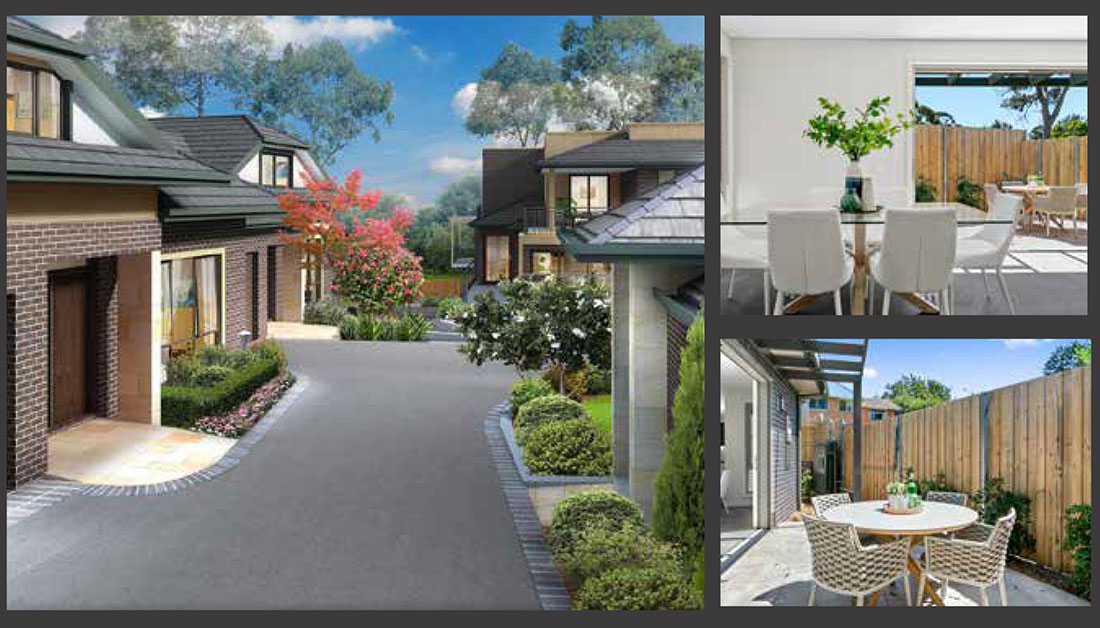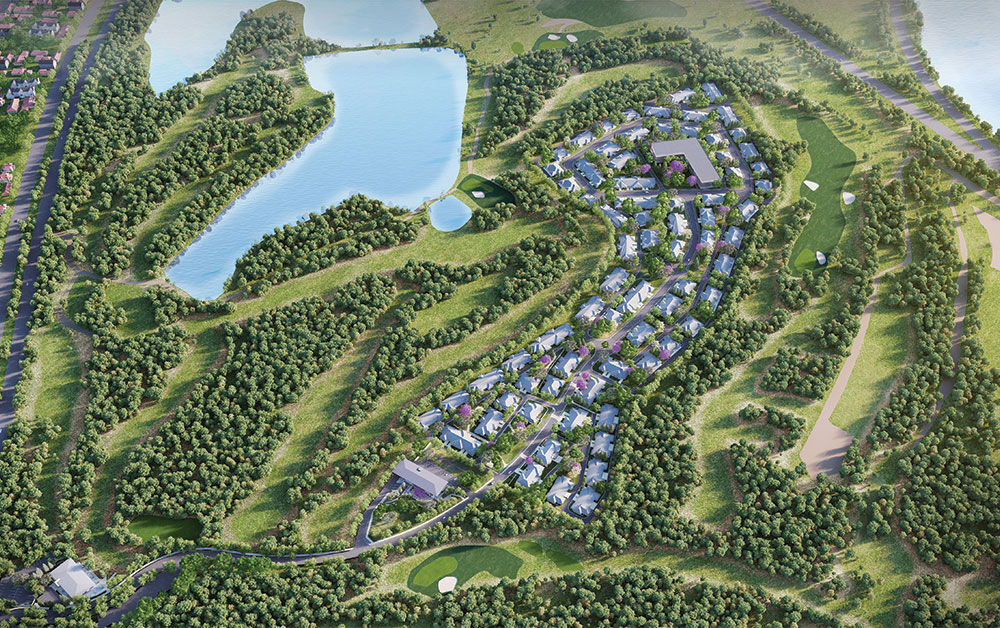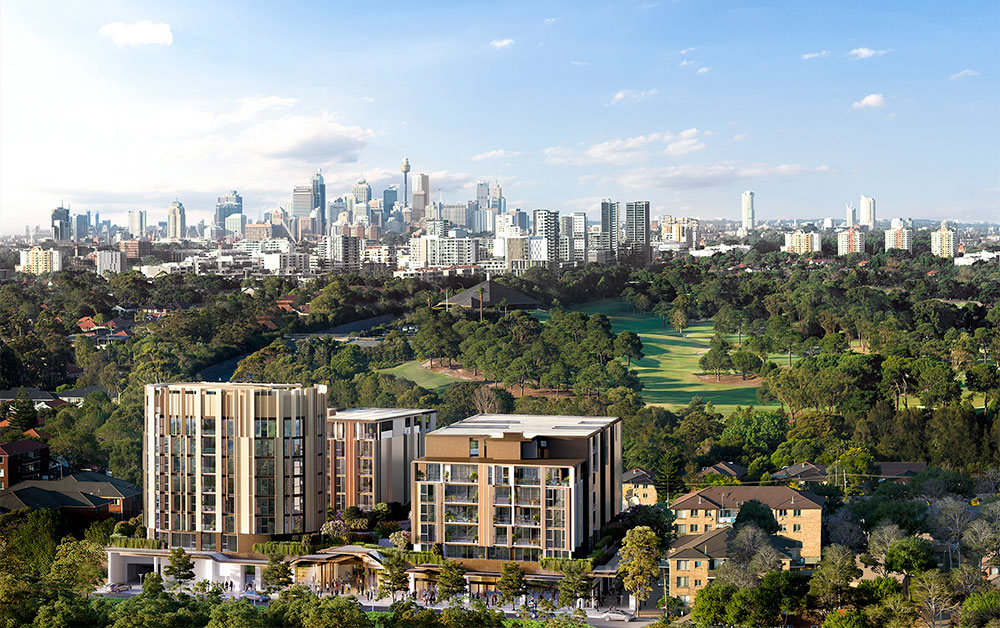Small rather than large residential golf estates is the new trend in golf-course living. And seniors living developments are at the forefront for many clubs that wish to secure their long-term future. Australian Golf Digest spoke to three experts about the phenomenon of ‘Retiring On The Fairway’.
It’s long been said the most desirable aspect for a home is water views. Not too far behind is golf-course frontage. It goes a long way to explaining the success of the residential golf phenomenon in Australia over the past quarter
of a century.
But times change despite Australia’s enviable 28-year record of sustained economic growth without a recession. So what do retirees want? Today, the No.1 concern for Australians is cost of living and the No.2 issue is security of information, according to Ray Ellis, chief executive officer of First National Real Estate.
Cost of living is a given across all demographics. But for older Australians, security of information poses an increasingly stressful aspect of daily life, says Ellis. It encompasses the stress caused by having your financial records given to third parties with the potential for fraud. It’s the fear of your health records being exposed online. It’s also the lack of privacy associated with social media platforms. And it’s wondering if your home is safe when travelling on holidays.
Security of information is part of the paranoia about the growing concerns among Australians. Hence, the appeal of ‘Retiring On The Fairway’ amounts to living with “like-minded people in a safe environment”, says Ellis. “Golf-course living is now a community precinct. And a community precinct gives you access to everything you want: fellowship, ecosystems, gardening, pleasure, golf, walking, eating.
“It’s taken the concept of the village to a new environment, which is called a community precinct. And it has an ecosystem that’s sustainable – by the way golf clubs now manage the environment and water. It’s the perfect blend of everything the world now wants.”

The residential golf phenomenon in America flourished in the mid-1990s when two golf courses on average were opening across the country every day. Developers added spas, tennis courts and formed community villages that were the community hub. Norman Rockwell’s vision of America came true in the form of golf estates.
However, golf is irrelevant for many people who live beside a golf course. Ellis recalls the time he bumped into a homeowner at Aviara residential golf estate, north of San Diego. As he walked past, Ellis asked: “What’s it like living on a golf course?”
To which the homeowner replied: “I don’t play golf. I hate golf.”
“Well, why do you live here?”
“Have you seen my back yard? I don’t have to do a thing. I walk around every day with 20 acres of garden.”
Trending:
Boutique rather than great residential golf estates
The residential golf phenomenon in Australia – which we refer to as ‘Living On The Fairway’ – peaked during the 2000s. Settlers Run in Melbourne and Stonecutters Ridge in Sydney are the most recent residential golf developments in Australia’s two largest cities that involved the construction of an 18-hole golf course as part of a master-planned community.
These major residential golf developments have come to a halt because they just aren’t financially viable anymore. Developers require large tracts of land on which to build an 18-hole golf course and the availability of large tracts is scarce around large metropolitan centres. The return on investment doesn’t stack up for the property developer.
 Increasingly, however, a number of privately owned clubs are exploring options to ‘offload’ a parcel of land to a property developer in order to secure their future. In Sydney, Brighton Lakes Recreation And Golf Club ensured its survival through a Project Delivery Agreement with Mirvac and a land transfer deal with Liverpool Council that saw a portion of the site developed into a 306-lot residential community. The embattled Strathfield Golf Club pocketed $52.5 million by selling off its driving range, clubhouse and carpark to reconfigure the course and build the Taj Mahal of clubhouses, which should generate substantially more revenue from wakes given the proximity to Rookwood Cemetery.
Increasingly, however, a number of privately owned clubs are exploring options to ‘offload’ a parcel of land to a property developer in order to secure their future. In Sydney, Brighton Lakes Recreation And Golf Club ensured its survival through a Project Delivery Agreement with Mirvac and a land transfer deal with Liverpool Council that saw a portion of the site developed into a 306-lot residential community. The embattled Strathfield Golf Club pocketed $52.5 million by selling off its driving range, clubhouse and carpark to reconfigure the course and build the Taj Mahal of clubhouses, which should generate substantially more revenue from wakes given the proximity to Rookwood Cemetery.
In Queensland, Burleigh Golf Club on the Gold Coast has gained development approval for a 150-bed retirement community to be developed in partnership with Retire Australia. Indooroopilly Golf Club in Brisbane has also recently gained approval for development of a 215-bed retirement community with Aura Holdings. Flagstaff Hill Golf Club in Adelaide is progressing with stage one of a similar themed development with Living Choice, stage two of which is to deliver a new clubhouse building.
Golf cubs in New South Wales may benefit from state zoning legislation that allows retirement developments accommodating over-55s (SEPP 65). Cumberland Country Club in Sydney’s west is exploring such an opportunity via leasehold agreement rather than direct land sale, with the development to also deliver new clubhouse amenities.
In Newcastle, Merewether Golf Club is undertaking an ambitious project with property developer Thirdi that will comprise a six-floor seniors living precinct. Newcastle Golf Club has followed the lead of Merewether and is pursuing an over-55s residential development with McCloys Stephens.
In Sydney’s northern suburbs, Muirfield Golf Club and Bayview Golf Club are exploring options with regard to seniors residential developments. Muirfield is believed to be spending $18 million on its clubhouse after a commercial agreement with property developer Arden Group.
This trend of ‘offloading land’ over the past five years is becoming a need for clubs simply because of operational realities. “For many it’s now the only opportunity they’ve got left to materially improve themselves,” says Jeff Blunden of Golf Business Advisory Services (GBAS).
This trend of ‘offloading land’ over the past five years is becoming a need for clubs simply because of operational realities.
“If you’ve got no other option and you can’t trade your way out of challenging times to a more sustainable position – one that can fund ongoing capital needs – then you have no option but to leverage some of your assets.”
Blunden says exiting some land is a trend that will likely continue for private golf clubs well into the future. Opportunities will, however, be dictated by the size of land available. The smaller the piece of land the smaller the opportunity for all parties for a materially beneficial outcome. Compromises to the golf course may be required and while likely unpopular, some clubs will probably have no choice.
These development projects don’t happen overnight, however. It takes sustained effort by directors to achieve desired outcomes. It’s often a three/four-year process and takes a committed board with a plan and the ability to execute the plan. Of course, any development proposal is also highly likely to encounter resistance – concerns from neighbours about losing views and increased traffic – NIMBY (Not In My Back Yard) issues from residents let alone disaffected members.
 Located directly opposite the undulating fairways of Pennant Hills Golf Club, Copeland Greens has embraced the concept of ‘Retiring By The Fairway’. Homeowners in the over-55s garden estate at Beecroft in Sydney’s north will have deluxe low-maintenance living in a fashionable suburban environment. The luxury villas and apartments, designed by architect Paul Meyer, feature spacious living and dining areas as well as expansive terraces/balconies for easy entertaining.
Located directly opposite the undulating fairways of Pennant Hills Golf Club, Copeland Greens has embraced the concept of ‘Retiring By The Fairway’. Homeowners in the over-55s garden estate at Beecroft in Sydney’s north will have deluxe low-maintenance living in a fashionable suburban environment. The luxury villas and apartments, designed by architect Paul Meyer, feature spacious living and dining areas as well as expansive terraces/balconies for easy entertaining.
Seniors living:
The Merewether experience
Merewether Golf Club in Newcastle has taken advantage of zoning legislation in NSW to create a seniors living development in exchange for course improvements and a clubhouse redevelopment. However, Merewether will retain ownership of the land to be used for the retirement complex.
Merewether is leasing a 1,400sqm parcel of land for 99 years to property developer Thirdi, which is building six floors of apartments for over-55s. A minimum of 150 units is planned, depending on the development approval.

Private golf clubs that own their own land are subject to state planning legislation. In NSW, seniors living complexes designed for over-55s are permitted on golf courses even if the zoning is non-residential. The NSW government actively encourages these properties for pensioners or older couples under State Environmental Planning Policy Number 65 (SEPP 65) whereas Victoria and other states don’t make allowances.
Therefore in some cases, it’s actually beneficial to have zoning as RE2 (recreational private) as opposed to general residential because it provides greater scope to undertake development. For example, Merewether is able to pursue a development with unlimited height restrictions. Whereas if its land were zoned residential it would have a limitation of, say, two floors.
Merewether put its development plan to tender on the open market to identify who had the best offering. The value of the land was placed at $16.5 million, which is the total amount the club will receive from Thirdi (pronounced Third-Eye).
Merewether has allocated $9 million for the construction of a new clubhouse. At least $1.5 million will be spent on course renovations as a consequence of the seniors living development. That provides for relocation of the maintenance shed and ensuring the course remains as an 18-hole layout and at least a par 70 during the construction period. Another $500,000 has been set aside for temporary facilities while $3.5 million will be invested into income-generating assets.
Rather than selling off part of its course, Merewether is actually leasing the parcel of land to Thirdi over a 99-year period. The developer has the right to put a seniors living development in place. The golf club earns an income off the lease and Merewether also receives a percentage of the initial sale of units as well as a percentage of the deferred management fee (DMF).
The contract accords the golf club a percentage of any apartments sold under the banner of that development. So Merewether collects 2 percent of the value of apartments that are sold to members (for instance, $20,000 on a $1 million unit). The developer wishes to minimise costs in the marketing of the apartments and similarly, the golf club wants as many members as possible to buy into the units.
Then every time an apartment is re-sold, a management fee is applied to the sale price. This is typical of all seniors living or aged-care units. For example, a person buys a seniors living apartment for $1 million. The person lives in that unit for 15 years before it’s sold for $2 million. In the Merewether instance, the DMF is 25 percent of the $2 million, which is $500,000. Therefore, the person receives $1.5 million upon the re-sale while Thirdi gets the residual balance of $500,000 and the golf club gets a share of that DMF.
All the risk is with the property developer rather than the golf club. Merewether retains ownership of the course but still gets the benefit of being able to utilise it, says Aaron Spalding, captain of Merewether Golf Club.
“Everything has been funded by the developer. We don’t do anything until we’ve either got the money from the developer or there is an approval stage which says we’re going to get the money.”
Off the back of what’s occurring at Merewether, Spalding formed a company (Valentem Consulting) to advise golf clubs. He figured that private golf courses have become targets of developers because they are asset-rich in terms of land. Because of the nature of club boards, they don’t necessarily have the knowledge to equally negotiate with developers.
With a background in finance and general management, Spalding says: “I have seen clubs not receiving full value from developers, in some cases outright predatory behaviour, so I’m seeking to help them out where I can.”
 Such is the appeal of Living On The Fairway that it’s a major selling aspect for developers. In marketing its Eastlakes Live project in Sydney’s east, Crown Group is promoting the fact its residential apartment complex sits on the doorstep of four golf courses that are less than one kilometre away. In fact, many residents at the 500-plus-apartment development will have magnificent views over The Australian Golf Club [left]. Hence, Living Near The Fairway is a pull factor for potential buyers at Eastlakes Live who would also have access to a retail precinct as well as a proposed 24-hour medical facility, childcare centre and community library.
Such is the appeal of Living On The Fairway that it’s a major selling aspect for developers. In marketing its Eastlakes Live project in Sydney’s east, Crown Group is promoting the fact its residential apartment complex sits on the doorstep of four golf courses that are less than one kilometre away. In fact, many residents at the 500-plus-apartment development will have magnificent views over The Australian Golf Club [left]. Hence, Living Near The Fairway is a pull factor for potential buyers at Eastlakes Live who would also have access to a retail precinct as well as a proposed 24-hour medical facility, childcare centre and community library.
Hope for ‘public’ courses
While development deals exist for private golf clubs that own their land, there are still opportunities for ‘public’ courses that lease land from a council, water utility or other landlord. Spalding says it’s worth examining the terms of the lease and what it allows.
For instance, if a club has a 50-year lease and the lease allows building on that land. It may be a case where it requires a renegotiation with council to say this is what needs to happen to ensure the ongoing viability of the golf club.
As long as council wants to ensure the ‘green space’ is maintained and isn’t seeking to replace the golf course with sporting fields, there is still scope to renegotiate a longer-term lease. And the longer the time-frame that is available, the more attractive the return from a developer’s viewpoint. Additionally, the prospect of a seniors living development integrated with the course delivers increased rates revenue to council.
Thinking laterally, senior residents have the potential to be the lifeblood of a golf club. A seniors living operator has a legislative requirement to provide food to all of its residents. So if a golf club puts in a caveat for food/beverage across the entire area, suddenly the club is in a position of authority to control the pricing and generate revenue.
Golf clubs need to think outside the square rather than “next year we’ll get 25 new members”. First National Real Estate’s Ellis says golf clubs may need to make brave decisions with regard to their land use: “It comes down to how a golf club is going to maximise their investment. Their strategic plan is to get more members. Well, how are they going to get more members if golf is a dying sport? How are they going to protect their asset?”



